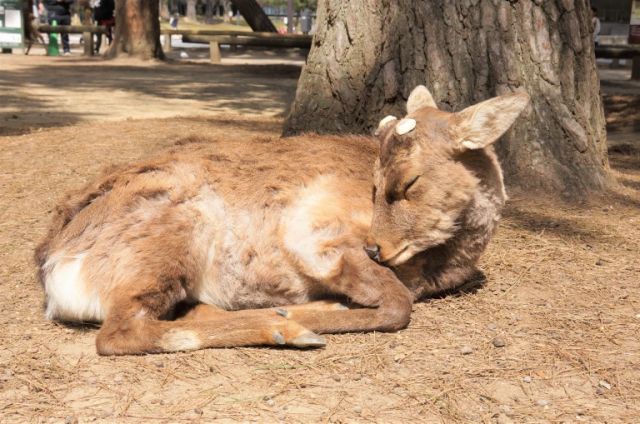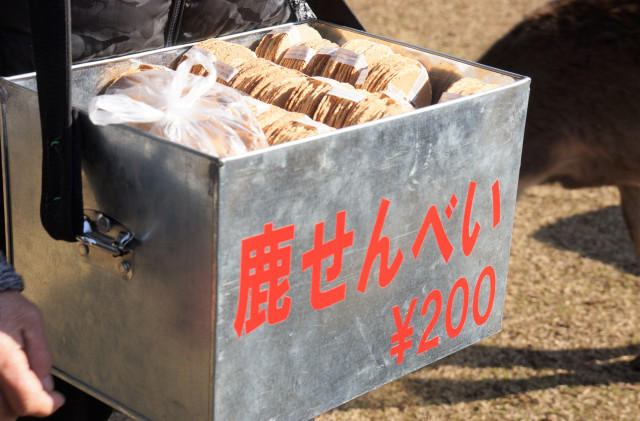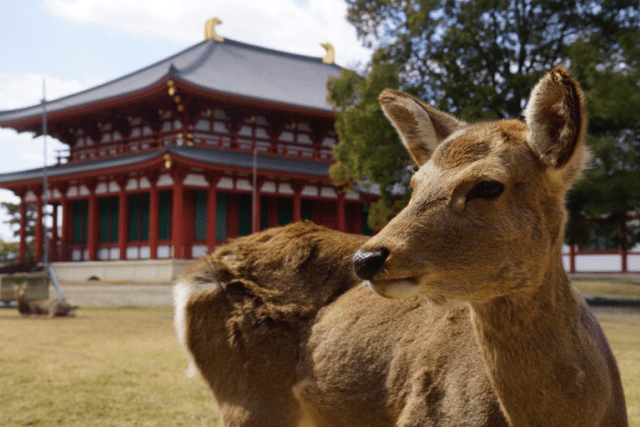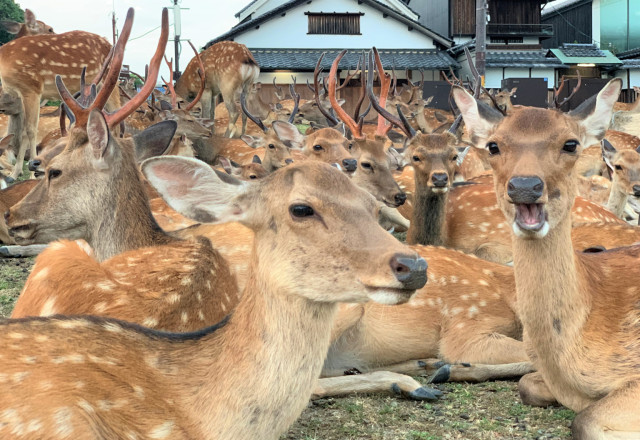
The coronavirus is affecting the health of Japan’s deer population at Nara Park.
The city of Nara in Nara prefecture is famous for its free-roaming deer population, who’ve been known to cross at pedestrian crossings and bow to tourists in Nara Park in return for senbei rice crackers.
The animals’ love for gathering around tourists who feed them rice crackers has been well-documented over the years, but now that the tourists have largely disappeared due to travel restrictions imposed during the coronavirus pandemic, it appears the deer’s dependence on senbei is more serious than first thought.
According to a recent news report, roughly 13 million tourists usually visit Nara Park every year, and the number of rice crackers sold annually amount to approximately 20 million. With around 900 deer living in the park, excluding the 400 that are housed in the “Rokuen” deer shelter, this means each deer usually eats more than 60 rice crackers per day.
▼ Shika Senbei (“Deer Rice Crackers”)
Each senbei weighs about three to four grams (0.1-0.14 ounces) and is considered a snack for the deer, who eat about five kilograms (11 pounds) of grass a day. However, the nutritional value of a rice cracker is higher than grass, making them extremely attractive to the animals. This encourages them to seek out the rice crackers to such an extent that some of the animals are said to have become dependent on them.
While a number of deer have adapted to the decrease in available rice crackers and switched to eating more grass due to the drop in tourists, some of the deer appear to have lost weight and are now roaming further away from the park, pointing to signs of a serious rice cracker dependence.
According to a recent survey conducted by The Nara Deer Preservation Foundation (N.D.P.F.) and Assistant Professor Shirow Tachizawa from Hokkaido University, it was found that the number of deer staying inside the nature-filled environment of Nara Park is decreasing.
In January this year, before the drop in tourists, 71.9 percent of the deer population was recorded in the park during the day, but in June this dropped to 50.2 percent. Nighttime numbers in the park were at 56.5 percent in January and 34.9 percent in June — a roughly 20-percent decrease in both cases.
While the number of deer in Nara Park has decreased, the number of deer sitting on the grass during the day has increased from 19.3 percent to 59.1 percent. Deer, like cows, digest nutrients through a system called rumination, which requires a lot of rest time, so this increase is a good sign as it indicates these deer are eating more grass and returning to a more healthy natural diet.
There have also been signs of improvement in the deer droppings, which have become firmer and darker compared to before the pandemic, when they were often loose. Like humans, deer need less refined food and more natural nourishment to maintain healthy levels of intestinal bacteria.
While a lot of the deer seem to be enjoying improved health without tourists, others are now worryingly thin due to their dependence on rice crackers. Assistant Professor Tachizawa, who specialises in the study of wild animals, believes these deer may have become addicted to senbei.
According to a previous survey, some deer ate more than 200 rice crackers a day, leading the Assistant Professor to speculate that these deer may have become so accustomed to receiving rice crackers that they are now finding it hard to adapt to the changes.
It seems that the coronavirus pandemic is affecting not only the lives of humans, but the lives of the deer at Nara Park as well. Here’s hoping more of the senbei-dependent deer are able to kick their addiction by mimicking the behaviour of their grass-eating relatives as soon as possible.
Otherwise the N.D.P.F. may have to step in to supplement the diet of the deer with more frequent acts of shikayose, the annual calling of the deer with acorns and a French horn.
Source: Sankei Shimbun via Hachima Kikou
Photos © SoraNews24
● Want to hear about SoraNews24’s latest articles as soon as they’re published? Follow us on Facebook and Twitter!






 Nara asks visitors to stop feeding the deer
Nara asks visitors to stop feeding the deer Nara unveils new vending machines that sell deer crackers
Nara unveils new vending machines that sell deer crackers Nara deer leave park, head to station for food as tourist numbers tumble due to coronavirus
Nara deer leave park, head to station for food as tourist numbers tumble due to coronavirus Shikayose: The Calling of the Deer in Nara with acorns and a French horn
Shikayose: The Calling of the Deer in Nara with acorns and a French horn Nara deer dies with four kilos of plastic in its stomach, tourists cautioned to feed animals properly
Nara deer dies with four kilos of plastic in its stomach, tourists cautioned to feed animals properly Japan may add Japanese language proficiency, lifestyle classes to permanent foreign resident requirements
Japan may add Japanese language proficiency, lifestyle classes to permanent foreign resident requirements Disillusionment at Tsukiji’s tourist-target prices led us to a great ramen restaurant in Tokyo
Disillusionment at Tsukiji’s tourist-target prices led us to a great ramen restaurant in Tokyo Starbucks unveils a range of secret Christmas cakes in Japan
Starbucks unveils a range of secret Christmas cakes in Japan Why you shouldn’t call this food “Hiroshimayaki” if you’re talking to people from Hiroshima
Why you shouldn’t call this food “Hiroshimayaki” if you’re talking to people from Hiroshima Ultra-premium matcha, koji rice mold star in Starbucks Japanese New Year’s Frappuccino and drinks
Ultra-premium matcha, koji rice mold star in Starbucks Japanese New Year’s Frappuccino and drinks Starbucks on a Shinkansen bullet train platform: 6 tips for using the automated store in Japan
Starbucks on a Shinkansen bullet train platform: 6 tips for using the automated store in Japan KFC Japan earned 6 billion yen over Christmas weekend, proving that Japan loves Christmas chicken
KFC Japan earned 6 billion yen over Christmas weekend, proving that Japan loves Christmas chicken Is the all-you-can-eat KFC buffet in Tokyo really as good as they say it is?
Is the all-you-can-eat KFC buffet in Tokyo really as good as they say it is? New Evangelion short anime, written by Hideaki Anno, to have world premiere early next year
New Evangelion short anime, written by Hideaki Anno, to have world premiere early next year Is the new Shinkansen Train Desk ticket worth it?
Is the new Shinkansen Train Desk ticket worth it? 7-Eleven Japan starts new temporary luggage storage service in over 300 branches
7-Eleven Japan starts new temporary luggage storage service in over 300 branches Starbucks teams up with 166-year-old Kyoto doll maker for Year of the Horse decorations【Photos】
Starbucks teams up with 166-year-old Kyoto doll maker for Year of the Horse decorations【Photos】 Tokyo’s Tsukiji sushi neighborhood asks tour groups to stay away for the rest of the month
Tokyo’s Tsukiji sushi neighborhood asks tour groups to stay away for the rest of the month Starbucks Japan releases new zodiac chilled cup drink for 2026
Starbucks Japan releases new zodiac chilled cup drink for 2026 Street Fighter Hadouken Churros to be launched and eaten in Tokyo, Okami pudding on offer too
Street Fighter Hadouken Churros to be launched and eaten in Tokyo, Okami pudding on offer too Is this the most relaxing Starbucks in Japan?
Is this the most relaxing Starbucks in Japan? Large amount of supposed human organs left in Osaka marketplace
Large amount of supposed human organs left in Osaka marketplace Japan’s human washing machines will go on sale to general public, demos to be held in Tokyo
Japan’s human washing machines will go on sale to general public, demos to be held in Tokyo Japanese train company is letting fans buy its actual ticket gates for their homes
Japanese train company is letting fans buy its actual ticket gates for their homes Tokyo considering law requiring more trash cans following litter increase in heavily touristed area
Tokyo considering law requiring more trash cans following litter increase in heavily touristed area Is China’s don’t-go-to-Japan warning affecting tourist crowds in Tokyo’s Asakusa neighborhood?
Is China’s don’t-go-to-Japan warning affecting tourist crowds in Tokyo’s Asakusa neighborhood? Nintendo’s Kirby now delivering orders at Kura Sushi restaurants, but not in Japan
Nintendo’s Kirby now delivering orders at Kura Sushi restaurants, but not in Japan Tokyo event lets you travel back in time, for free, to celebrate 100 years since Showa era start
Tokyo event lets you travel back in time, for free, to celebrate 100 years since Showa era start Survey asks foreign tourists what bothered them in Japan, more than half gave same answer
Survey asks foreign tourists what bothered them in Japan, more than half gave same answer Japan’s deadliest food claims more victims, but why do people keep eating it for New Year’s?
Japan’s deadliest food claims more victims, but why do people keep eating it for New Year’s? We deeply regret going into this tunnel on our walk in the mountains of Japan
We deeply regret going into this tunnel on our walk in the mountains of Japan Studio Ghibli releases Kodama forest spirits from Princess Mononoke to light up your home
Studio Ghibli releases Kodama forest spirits from Princess Mononoke to light up your home Major Japanese hotel chain says reservations via overseas booking sites may not be valid
Major Japanese hotel chain says reservations via overseas booking sites may not be valid Put sesame oil in your coffee? Japanese maker says it’s the best way to start your day【Taste test】
Put sesame oil in your coffee? Japanese maker says it’s the best way to start your day【Taste test】 The top 10 annoying foreign tourist behaviors on trains, as chosen by Japanese people【Survey】
The top 10 annoying foreign tourist behaviors on trains, as chosen by Japanese people【Survey】 No more using real katana for tourism activities, Japan’s National Police Agency says
No more using real katana for tourism activities, Japan’s National Police Agency says Starbucks Japan reveals new sakura drinkware collection, inspired by evening cherry blossoms
Starbucks Japan reveals new sakura drinkware collection, inspired by evening cherry blossoms Deer killed by man with axe in Nara
Deer killed by man with axe in Nara Nara deer stampede into marathon, hit runner in their path
Nara deer stampede into marathon, hit runner in their path Deer in Nara Park mysteriously disappear during this year’s shikadamari season
Deer in Nara Park mysteriously disappear during this year’s shikadamari season Deer in Nara Park outnumber visitors, display baffling summer gathering behaviour
Deer in Nara Park outnumber visitors, display baffling summer gathering behaviour The poo from Nara Park’s deer is changing because of the coronavirus pandemic
The poo from Nara Park’s deer is changing because of the coronavirus pandemic Nara deer shikadamari mystery deepens as tourists return to Nara park
Nara deer shikadamari mystery deepens as tourists return to Nara park Deer in Nara refuse crackers after Golden Week visitors leave them too full to eat【Photos】
Deer in Nara refuse crackers after Golden Week visitors leave them too full to eat【Photos】 With foreign visitor numbers to Nara Park plummeting, are the city’s deer in danger of starving?
With foreign visitor numbers to Nara Park plummeting, are the city’s deer in danger of starving? Record number of people injured by deer in Nara this year
Record number of people injured by deer in Nara this year Bizarre “shikadamari” deer gathering at Nara Park baffles people in Japan
Bizarre “shikadamari” deer gathering at Nara Park baffles people in Japan Increased tourist numbers in Nara Park are affecting the size of its deer population
Increased tourist numbers in Nara Park are affecting the size of its deer population Shikadamari: The Nara deer summer gathering phenomenon that baffles visitors every year
Shikadamari: The Nara deer summer gathering phenomenon that baffles visitors every year Nara deer have a heartfelt message for tourists in new travel poster
Nara deer have a heartfelt message for tourists in new travel poster Nara’s “deer cookie” rice crackers get their first price increase in 28 years
Nara’s “deer cookie” rice crackers get their first price increase in 28 years During Golden Week rush, Nara deer so overwhelmed with rice crackers they wear them as hats
During Golden Week rush, Nara deer so overwhelmed with rice crackers they wear them as hats
Leave a Reply